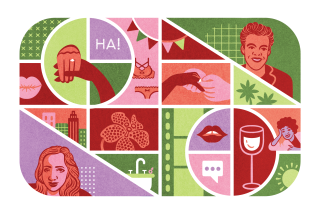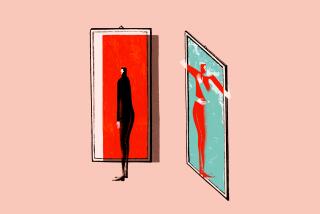Column: How I relearned the power and the lost art of the handwritten love letter

- Share via
In a gray box inside my closet, I have a thick pile of love letters I plan to keep forever. Most are from ex-boyfriends trying to win me back post-breakup. I fantasize about sharing them with a granddaughter when I’m 90 and exaggerating the romance of my youth. “In my day, I broke a lot of hearts,” I’ll say wistfully.
But my most treasured love letter is from one of my best friends, B. It’s a one-page, handwritten letter, left at my doorstep with a bouquet of sunflowers, calla lilies, hyacinths and daisies years ago when I was having trouble getting over a man (one of the few who didn’t try to win me back). B’s letter is the most romantic in my pile. It rehashed no drama. It made no excuses. It simply let me know that I was loved.
Opinion Columnist
Jean Guerrero
Jean Guerrero is the author, most recently, of “Hatemonger: Stephen Miller, Donald Trump and the White Nationalist Agenda.”
Reflecting on her gift, and the dying art of handwritten letters in our age of emails and emoticons, I decided to try an experiment: Instead of buying gifts for family members this Christmas, I would write them long, heartfelt love letters by hand. I dismissed my worry that I would seem cheap or lazy. Writing by hand can be time-consuming, bone-aching work, particularly when you’re doing it for more than a dozen people.
In our digital era, most of us rarely take the time to share deeply considered thoughts and emotions with the people in our lives. What might we gain if instead of participating in mindless consumerism over the holidays, we were to spend them contemplating our loved ones and communicating our feelings by hand?
I love spending holidays with my family, particularly the matriarchs. But I know what comments to expect from my mom, aunts and others.
Whenever I make someone a gift, such as a hand-crafted necklace or box of mementos, they seem to cherish it more, wearing it often or displaying it prominently. And there’s something extra special about a handwritten letter. Personality radiates off the page. The shapes of words preserve the quirks of the author’s interior life and physical body. As fragile as handwritten letters can be, many of us tend to keep them a long time — much longer than we keep most of our digital communications.
Technology, of course, is displacing this form. First came typewriters and keyboards. Now a new brain-computer interface lets people type with their minds. What are we losing when we forfeit the physical labor behind the written word? We tend to value what we struggle for. Have we devalued the human exchange of ideas?
I drove to a Staples to buy nice stationery and a fancy pen, but settled on simple gray-lined notebook paper and a pack of 24 pencils, which I hadn’t used since college. I was trying to be realistic: After years of not handwriting anything, my brain had become accustomed to spewing nonsense and hitting “Delete” before producing anything readable. If I used a pen, I’d end up crumpling up most of my letters and restarting them over and over. With an eraser, I could manually undo individual mistakes without ruining my previous work.
Racial identity is as personal as it is a product of how we’re seen. But what is obvious to me about my Latino relatives is not how many of them see themselves.
While preparing for the task, I thought of all the letters that have left a mark on me. My grandmother has a royal blue chest in her closet filled with old photos and carefully preserved love letters, including adorable ones my father wrote on notebook paper as a child, signing them, “Marco who adores you,” in Spanish. His handwriting was identical to mine; in the soft curves of his words I saw myself as a child. I’d known my father only as a rough-edged machista. Here was an earlier version of him, a sweet 12-year-old boy.
Clearly, that’s something we’re losing with the decline of the handwritten letter: the ability to know more deeply the people we came from and who we once were. In my grandmother’s chest I also eavesdropped on my great-grandfather Antonio, who died before I was born. In 1933, after doing time in a U.S. prison and being deported to Mexico, he wrote an outlandishly passionate love letter to my great-grandmother begging her to be with him, signing it, “he who sighs and suffers for you.”
The film is a rare product of mainstream culture that invites men to reimagine masculinity for their own sake.
When I was 27, doing research for my first book by rummaging through my mother’s garage, I came across a letter she wrote to her parents when she was 27. She had just moved to New York from Puerto Rico for her medical residency and was sharing her raw experience. I was struck by her easy, honest style. She seemed so close and comfortable with her parents. It was a rapport I didn’t have with her.
Surely, our strained communications were a product of her raising me and my sister in the mainland, where we assimilated into a different culture. But perhaps they were also tied to the dying of this very form, which is rooted in careful reflection and creates a safer space for vulnerability.
I was inspired by my mother’s letter to her parents when I sat down to write my letter to her. I wanted her to know my love, and to close the rupture that technology and culture had created between us. With each sentence, I was discovering new and deeper ways of seeing my mother, and making myself known to her in more profound ways as well.
Eight single-space pages later, the eraser on my first pencil was gone and my hand was aching but I was done. I reread the letter, with its barely-there ghosts of erased words. It had taken me six hours. I placed it in a large brown envelope and sealed it with wax.
It was only the first of my love letters, but it was already clear: What had begun as a fun Christmas project was in fact one of the most important undertakings of my life.
More to Read
A cure for the common opinion
Get thought-provoking perspectives with our weekly newsletter.
You may occasionally receive promotional content from the Los Angeles Times.















